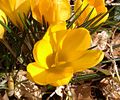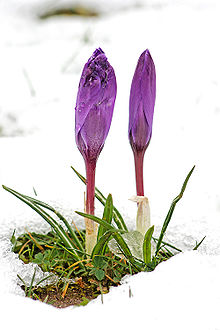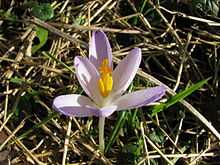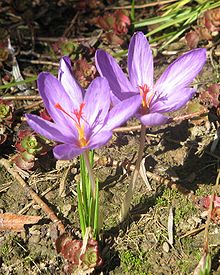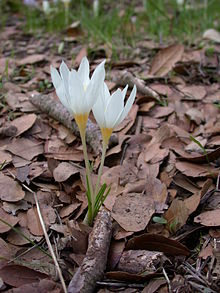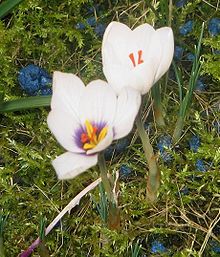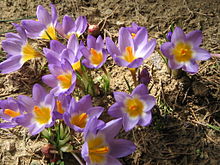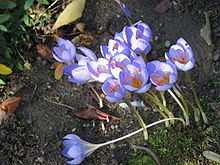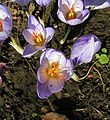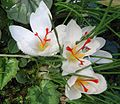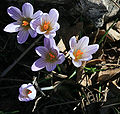- Crocus
-
For other uses, see Crocus (disambiguation).
Crocus 
Crocus longiflorus Scientific classification Kingdom: Plantae Superdivision: Spermatophyta (unranked): Angiosperms (unranked): Monocots Order: Asparagales Family: Iridaceae Subfamily: Crocoideae Genus: Crocus
L.Type species Crocus sativus
L.Species See text.
Crocus (plural: crocuses, croci) is a genus in the iris family comprising about 80 species of perennials growing from corms. Many are cultivated for their flowers appearing in autumn, winter, or spring. Crocuses are native to woodland, scrub and meadows from sea level to alpine tundra in central and southern Europe, North Africa and the Middle East, on the islands of the Aegean, and across Central Asia to western China.
Contents
Etymology
The name of the genus is derived from the Greek krokos (κρόκος). This in turn is probably a loan word from a Semitic language, related to Hebrew כרכום karkōm, Aramaic ܟܟܘܪܟܟܡܡܐ kurkama, Persian and Arabic كركم kurkum, which mean saffron or saffron yellow.[1] The name ultimately comes from Sanskrit कुङ्कुमं kunkumam, unless the Sanskrit word is from the Semitic one.[2]
Description
There are about eighty species of crocus (of which approximately 30 are cultivated). Their cup-shaped, solitary, salverform flowers taper off into a narrow tube. Their color varies enormously, although lilac, mauve, yellow and white are predominant. The grass-like, ensiform leaf[3] shows generally a white central stripe along the leaf axis. The leaf margin is entire. Crocuses typically have three stamens. The spice saffron is obtained from the stigmas of Crocus sativus, an autumn/fall-blooming species.
Autumn
Some Crocus species, known as "autumn crocus", flower in September to November in the Northern Hemisphere. Some flower before their leaves appear. Autumn/fall flowering species include: Crocus banaticus (syn. C. iridiflorus), C.cancellatus, C. goulimyi, C. hadriaticus, C. kotschyanus (syn. C. zonatus), C. laevigatus, Crocus ligusticus (syn. C. medius ), C. niveus, C. nudiflorus, C. ochroleucus, C. pulchellus, C. sativus (saffron crocus), C. serotinus, C. speciosus, C. tournefortii. Crocus laevigatus has a long flowering-period which starts in late autumn or early winter and may continue into February.
Cultivation
Cultivated varieties mainly represent five species: C. vernus, C. chrysanthus, C. flavus, C. sieberi and C. tommasinianus. Among the first flowers to bloom in spring, crocuses are popular with gardeners. Their flowering time varies from the late winter C. tommasinianus to the later large hybridized and selected Giant "Dutch crocuses" (C. vernus). Crocus flowers and leaves are protected from frost by a waxy cuticle; in areas where snow and frost occasionally occur in the early spring, it is not uncommon to see early-flowering crocus blooming through a light late snowfall (right).
Most crocus species and hybrids should be planted in a sunny position, in gritty, well-drained soil, although a few prefer shadier sites in moist soil. Some are suitable for naturalising in grass. The corms should be planted about 3 to 4 cm deep; in heavy soils a quantity of sharp grit should be worked in to improve drainage.
Some crocuses, especially C. tommasinianus and its selected forms and hybrids (such as 'Whitewell Purple' and 'Ruby Giant'), seed prolifically and are ideal for naturalising. They can, however, become weeds in rock gardens, where they will often appear in the middle of choice, mat-forming alpine plants and can be difficult to remove.
History
Cultivation and harvesting of crocus was first documented in the Mediterranean, notably on the island of Crete. Frescos showing them are extant at the Knossos site on Crete[4] as well as from a comparably aged site on Santorini.
The first crocus seen in the Netherlands, where Crocus species are not native, were from corms brought back in the 1560s from Constantinople by the Holy Roman Emperor's ambassador to the Sublime Porte, Ogier Ghiselin de Busbecq. A few corms were forwarded to Carolus Clusius at the botanical garden in Leiden. By 1620, the approximate date of Ambrosius Bosschaert's painting (illustration, below), new garden varieties had been developed, such as the cream-colored crocus feathered with bronze at the base of the bouquet, similar to varieties still on the market. Bosschaert, working from a preparatory drawing to paint his composed piece spanning the whole of Spring, exaggerated the crocus so that it passes for a tulip, but its narrow, grasslike leaves give it away.
-
Saffron gatherers appear in Minoan frescos on the island of Santorini in the Aegean Sea. See History of saffron
-
Composed Bouquet of Spring Flowers, by Ambrosius Bosschaert, c. 1620 (Louvre Museum)
-
Crocus angustifolius (Cloth of gold) from Curtis's Botanical Magazine, 1803
Species
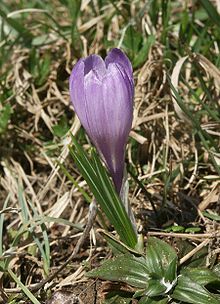 Crocus vernus subsp. vernus (Section Crocus, Series Verni)
Crocus vernus subsp. vernus (Section Crocus, Series Verni)
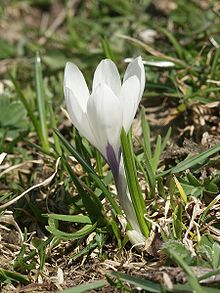 Crocus vernus subsp. albiflorus (Section Crocus, Series Verni)
Crocus vernus subsp. albiflorus (Section Crocus, Series Verni)
The taxonomic classification proposed by Brian Mathew in 1982 was based mainly on three character states:
The seven species that have been discovered since then have been integrated into this classification.[5]
Molecular analysis carried out at the University of Copenhagen suggests that this classification should be reviewed. In particular, the DNA data suggest that there are no grounds for isolating Crocus banaticus in its own subgenus Crociris, even though it is a unique species in the genus. Because it has a prophyll at the base of the pedicel it therefore would fall within section Crocus, although its exact relationship to the rest of the subgenus remains unclear.
Another anomalous species, Crocus baytopiorum, should now be placed in a series of its own, series Baytopi. Crocus gargaricus subsp. herbertii has been raised to species status, as Crocus herbertii. Perhaps most surprisingly, autumn-flowering Crocus longiflorus, the type species of series Longiflori (long regarded by Mathew as "a disparate assemblage"), now seems to lie within series Verni. In addition the position of Crocus malyi is currently unclear.
DNA analysis and morphological studies suggest further that series Reticulati, series Biflori and series Speciosi are "probably inseparable". Crocus adanensis and Crocus caspius should probably be removed from Biflori; Crocus adanensis falls in a clade with Crocus paschei as a sister group to the species of series Flavi; Crocus caspius appears to be sister to the species of series Orientales.
The study shows "…no support for a system of sections as currently defined", although, despite the many inconsistencies between Mathew's 1982 classification and the current hypothesis, "…the main assignment of species to the sections and series of that system is actually supported." The authors state that "…further studies are required before any firm decisions about a hierarchical system of classification can be considered" and conclude that "future re-classification is likely to involve all infrageneric levels, subgenera, sections and series".[6]
Below is the classification proposed by Brian Mathew in 1982, adapted in accordance with the above findings:
- A. Section Crocus : species with a basal prophyll
-
- Series Verni: corms with reticulated fibers, spring-flowering (apart from Crocus longiflorus), flowers for the most part without conspicuous outer striping, bracts absent
- Crocus etruscus Parl.
- Crocus kosaninii Pulevic
- Crocus longiflorus Raf. - Italian crocus (formerly in Series Longiflori)[6]
- Crocus tommasinianus Herb. - Woodland crocus, Tommasini's crocus
- Crocus vernus (L.) Hill - Spring crocus, Dutch crocus
- Crocus vernus subsp. albiflorus (Kit. ex Schult.) Asch. & Graebn.
- Crocus vernus subsp. vernus
- Series Verni: corms with reticulated fibers, spring-flowering (apart from Crocus longiflorus), flowers for the most part without conspicuous outer striping, bracts absent
-
- Series Scardici: spring-flowering, leaves have no pale stripe on the upper surface
- Crocus pelistericus Pulevic
- Crocus scardicus Kos.
- Series Scardici: spring-flowering, leaves have no pale stripe on the upper surface
-
- Series Versicolores: spring-flowering, corms with tunics, which for the most part have parallel fibers, flowers with conspicuous exterior striping
- Crocus cambessedesii
- Crocus versicolor Ker Gawl. - cloth-of-silver crocus
- Crocus corsicus Vanucchi ex Maw
- Crocus imperati Ten.
- Crocus imperati subsp. imperati
- Crocus imperati subsp. suaveolens (Bertol.) B.Mathew
- Crocus minimus DC.
- Series Versicolores: spring-flowering, corms with tunics, which for the most part have parallel fibers, flowers with conspicuous exterior striping
-
- Series Longiflori: autumn-flowering, yellow anthers, styles much divided
- Crocus goulimyi Turrill (see also Constantine Goulimis)
- Crocus ligusticus M.G. Mariotti (Syn. Crocus medius Balb.)
- Crocus niveus Bowles
- Crocus nudiflorus Smith.
- Crocus serotinus Salisb. - late crocus
- Crocus serotinus subsp. clusii (J.Gay) B.Mathew
- Crocus serotinus subsp. salzmannii (J.Gay) B.Mathew
- Crocus serotinus subsp. serotinus
- Series Longiflori: autumn-flowering, yellow anthers, styles much divided
-
- Series Kotschyani: autumn-flowering, anthers white, styles for the most part three-forked
- Crocus autranii Albov.
- Crocus gilanicus B. Matthew (discovered in 1973 and named after Gilan province in Iran where it was first found)
- Crocus karduchorum Kotschy ex Maw
- Crocus kotschyanus K. Koch - Kotschy's crocus (syn. C. zonatus)
- Crocus kotschyanus subsp. cappadocicus B.Mathew
- Crocus kotschyanus subsp. hakkariensis B.Mathew
- Crocus kotschyanus subsp. kotschyanus
- Crocus kotschyanus subsp. suworowianus (K.Koch) B.Mathew
- Crocus ochroleucus Boiss. & Gaill.
- Crocus scharojanii Ruprecht
- Crocus scharojanii subsp. scharojanii
- Crocus scharojanii subsp. lazicus (Boiss.) B.Mathew
- Crocus vallicola Herb.
- Series Kotschyani: autumn-flowering, anthers white, styles for the most part three-forked
-
- Series Crocus: autumn-flowering, anthers yellow, style distinctly three-branched
- Crocus asumaniae B. Mathew & T. Baytop
- Crocus cartwrightianus Herb.
- Crocus hadriaticus Herb.
- Crocus hadriaticus subsp. hadriaticus
- Crocus hadriaticus subsp. parnassicus (B.Mathew) B.Mathew
- Crocus hadriaticus subsp. parnonicus B.Mathew
- Crocus moabiticus Bornm. & Dinsmore ex Bornm.
- Crocus mathewii H. Kemdorff & E. Pasche (1994)
- Crocus naqabensis Al-Eisawi (2001)
- Crocus oreocreticus B.L. Burtt
- Crocus pallasii Goldb.
- Crocus pallasii subsp. dispathaceus (Bowles) B.Mathew
- Crocus pallasii subsp. haussknechtii (Boiss. & Reut. ex Maw) B.Mathew
- Crocus pallasii subsp. pallasii
- Crocus pallasii subsp. turcicus B.Mathew
- Crocus thomasii Ten.
- Series Crocus: autumn-flowering, anthers yellow, style distinctly three-branched
-
- Position unclear [6]
- Crocus malyi Vis. (formerly in Series Versicolores)
- Crocus banaticus Heuff. (formerly in obsolete Subgenus Crociris)
- Position unclear [6]
- B. Section Nudiscapus: species without a basal prophyll
-
- Series Reticulati: corm tunic for the most part decidedly covered with reticulated fibers, flower produced in winter or spring, style three-forked or much divided
- Crocus abantensis T.Baytop & B.Mathew
- Crocus ancyrensis (Herb.) Maw - Ankara crocus
- Crocus angustifolius Weston - cloth-of-gold crocus
- Crocus cancellatus Herb.
- Crocus cancellatus subsp. cancellatus
- Crocus cancellatus subsp. damascenus (Herb.) B.Mathew
- Crocus cancellatus subsp. lycius B.Mathew
- Crocus cancellatus subsp. mazziaricus (Herb.) B.Mathew
- Crocus cancellatus subsp. pamphylicus B.Mathew
- Crocus cvijicii Kos.
- Crocus dalmaticus Vis.
- Crocus gargaricus Herb.
- Crocus herbertii B. Mathew (became a "true" species)[6]
- Crocus hermoneus Kotschy ex Maw
- Crocus reticulatus Steven ex Adams
- Crocus reticulatus subsp. hittiticus (T.Baytop & B.Mathew) B.Mathew
- Crocus reticulatus subsp. reticulatus
- Crocus robertianus C.D. Brickell
- Crocus rujanensis Randjel. & D.A. Hill (1990)
- Crocus sieberi J. Gay - Sieber's crocus, Cretan crocus
- Crocus sieberi subsp. atticus (Boiss. & Orph.) B.Mathew
- Crocus sieberi subsp. nivalis (Bory & Chaub.) B.Mathew
- Crocus sieberi subsp. sieberi
- Crocus sieberi subsp. sublimis (Herb.) B.Mathew
- Crocus sieheanus Barr ex B.L. Burtt
- Crocus veluchensis Herb.
- Series Reticulati: corm tunic for the most part decidedly covered with reticulated fibers, flower produced in winter or spring, style three-forked or much divided
-
- Series Biflori: tunics of corms split into rings at the base, either entire or with toothlike projections, leathery in texture, spring- or late-winter flowering, style three-forked
- Crocus aerius Herb.
- Crocus almehensis C.D. Brickell & B. Mathew
- Crocus biflorus Mill. - Silvery crocus, Scotch crocus
- Crocus biflorus subsp. biflorus
- Crocus biflorus subsp. adamii (J.Gay) K.Richt.
- Crocus biflorus subsp. alexandri (Nicic ex Velen.) B. Mathew
- Crocus biflorus subsp. artvinensis (J.Philippow) B. Mathew
- Crocus biflorus subsp. atrospermus Kernd. & Pasche
- Crocus biflorus subsp. caelestis Kernd. & Pasche
- Crocus biflorus subsp. caricus Kernd. & Pasche
- Crocus biflorus subsp. crewei (Hook.f.) B. Mathew
- Crocus biflorus subsp. fibroannulatus Kernd. & Pasche
- Crocus biflorus subsp. ionopharynx Kernd. & Pasche
- Crocus biflorus subsp. isauricus (Siehe ex Bowles) B.Mathew
- Crocus biflorus subsp. leucostylosus Kernd. & Pasche
- Crocus biflorus subsp. melantherus B. Mathew
- Crocus biflorus subsp. nubigena (Herb.) B. Mathew
- Crocus biflorus subsp. pseudonubigena B. Mathew
- Crocus biflorus subsp. pulchricolor (Herb.) B. Mathew
- Crocus biflorus subsp. punctatus B.Mathew
- Crocus biflorus subsp. stridii (Papan. & Zacharof) B.Mathew
- Crocus biflorus subsp. tauri (Maw) B. Mathew
- Crocus biflorus subsp. weldenii (Hoppe & Fuernr.) B. Mathew
- Crocus biflorus subsp. yataganensis Kernd. & Pasche
- Crocus chrysanthus Herb. - Golden crocus, Snow crocus
- Crocus chrysanthus subsp. chrysanthus
- Crocus chrysanthus subsp. multifolius Papan. & Zacharof
- Crocus cyprius Boiss. & Kotschy
- Crocus danfordiae Maw
- Crocus danfordiae subsp. danfordiae
- Crocus danfordiae subsp. kurdistanicus Maroofi & Assadi
- Crocus hartmannianus Holmboe
- Crocus kerndorffiorum Pasche (1993)
- Crocus leichtlinii (Dewar) Bowles
- Crocus nerimaniae Yüzbasioglu & Varol (2004)
- Crocus pestalozzae Boiss.
- Crocus wattiorum (B. Mathew, 1995) B. Mathew (2000)
- Series Biflori: tunics of corms split into rings at the base, either entire or with toothlike projections, leathery in texture, spring- or late-winter flowering, style three-forked
-
- Series Speciosi: corm tunic splits into rings at the base, leathery or membranous, foliage after the flowers, autumn-flowering, style much divided
- Crocus pulchellus Herb. - hairy crocus
- Crocus speciosus M. Bieb. - Bieberstein's crocus, large purple crocus
- Crocus speciosus subsp. ilgazensis B.Mathew
- Crocus speciosus subsp. speciosus
- Crocus speciosus subsp. xantholaimos B.Mathew
- Series Speciosi: corm tunic splits into rings at the base, leathery or membranous, foliage after the flowers, autumn-flowering, style much divided
-
- Series Orientales: corm with parallel fibers or lightly reticulated, numerous leaves, spring-flowering, style three-forked
- Crocus alatavicus Semenova & Reg.
- Crocus caspius Fischer & Meyer (formerly in Series Biflori)
- Crocus korolkowii Regel ex Maw - celandine crocus
- Crocus michelsonii B. Fedtsch.
- Series Orientales: corm with parallel fibers or lightly reticulated, numerous leaves, spring-flowering, style three-forked
-
- Series Flavi: tunics of the corms membranous, split into parallel fibers, spring-flowering, styles much divided
- Crocus adanensis T. Baytop & B. Mathew (formerly in Series Biflori)
- Crocus antalayensis Mathew
- Crocus candidus E.D. Clarke
- Crocus flavus Weston - Yellow crocus
- Crocus flavus subsp. flavus
- Crocus flavus subsp. dissectus T.Baytop & B.Mathew
- Crocus graveolens Boiss. &Reut.
- Crocus hyemalis Boiss.
- Crocus olivieri Gray
- Crocus paschei H. Kerndorff (1993)
- Crocus vitellinus Wahl.
- Series Flavi: tunics of the corms membranous, split into parallel fibers, spring-flowering, styles much divided
-
- Series Aleppici: tunics of the corms membranous, with split, parallel fibers, foliage produced at the same time as the flowers, fall- or winter-flowering
- Crocus aleppicus Baker
- Crocus boulosii Greuter
- Crocus veneris Tappein ex Poech
- Series Aleppici: tunics of the corms membranous, with split, parallel fibers, foliage produced at the same time as the flowers, fall- or winter-flowering
-
- Series Carpetani: undersurface of the leaves rounded with grooves, upper surface channeled, spring-flowering, style whitish, obscurely divided
- Crocus carpetanus Boiss. & Reut.
- Crocus nevadensis Amo & Campo
- Series Carpetani: undersurface of the leaves rounded with grooves, upper surface channeled, spring-flowering, style whitish, obscurely divided
-
- Series Intertexti: corm tunic fibrous with fibers interwoven, spring-flowering
- Crocus fleischeri J.Gay.
- Series Intertexti: corm tunic fibrous with fibers interwoven, spring-flowering
-
- Series Laevigatae: corm tunic membranous or splitting into parallel fibers, sometimes leathery, foliage produced at the same time as flowers, autumn-flowering, anthers white, style much divided
- Crocus boryi J.Gay
- Crocus laevigatus Bory & Chaub.
- Crocus tournefortii J.Gay.
- Series Laevigatae: corm tunic membranous or splitting into parallel fibers, sometimes leathery, foliage produced at the same time as flowers, autumn-flowering, anthers white, style much divided
Similar species
Though some true crocus bloom with the fall (autumnal) rains, after summer's heat and drought, the name autumn crocus is often used as a common name for Colchicum, which is in the lily family (Liliaceae), and which has six stamens; it is also known as meadow saffron, though unlike true saffron, the plant is toxic.
The so-called prairie crocus (formerly Anemone patens, now Pulsatilla patens or P. ludoviciana) belongs to the buttercup family (Ranunculaceae).
Metaphorical use
The financial community sometimes refers to companies or economic sectors that rise early after an economic downturn as "crocuses" in reference to the flower's ability to thrive in the late winter or early spring.[8]
References
Footnotes
- ^ Babiniotis, Leksiko tis neoellinikis glossas.
- ^ http://www.etymonline.com/index.php?term=crocus
- ^ Ensiform: Having sharp edges and tapering to a slender point, like a sword blade.
- ^ C. Michael Hogan, Knossos fieldnotes, Modern Antiquarian (2007)
- ^ Gitte Petersen, Ole Seberg, Sarah Thorsøe, Tina Jørgensen & Brian Mathew: A phylogeny of the genus Crocus (Iridaceae) based on sequence data from five plastid regions. Taxon, 57 (2), 2008, pp. 487–499
- ^ a b c d e f Brian Mathew, Gitte Petersen & Ole Seberg, A reassessment of Crocus based on molecular analysis, The Plantsman (N.S.) Vol 8, Part 1, pp50–57, March 2009
- ^ The crocus of Istanbul
- ^ Example of Metaphorical Use
Bibliography
- E.A. Bowles, A Handbook of Crocus and Colchicum for Gardeners, Martin Hopkinson 1924
- Brian Mathew, Christopher Grey-Wilson, Bulbs, (ill. Marjorie Blamey), Collins, 1981
- Brian Mathew, Crocus: A Revision of the Genus Crocus, Timber Press, 1983. ISBN 0-917304-23-3
- Brian Mathew, Flowering Bulbs for the Garden, Collingridge/Royal Botanic Gardens, Kew, 1987. ISBN 0-600-35175-0
- Novica Randjelovic, David A. Hill, Vladimir Randjelovic, 'The Genus Crocus L. in Serbia'. Serbian Academy of Sciences and Arts, Belgrade, 1990 (in English)
- Maw, George. A Monograph of the Genus Crocus. London, Dulau and Co., 1886
- Rix, Alison. George Maw, Joseph Hooker and the genus Crocus, Curtis's Botanical Magazine, Volume 25 Issue 2, Pages 176 - 187, 2008
- The Pleasures of Crocus, Royal New Zealand Institute of Horticulture 1996
External links
Categories:- Flowers
- Iridaceae genera
- Garden plants
- Arabic words and phrases
Wikimedia Foundation. 2010.


